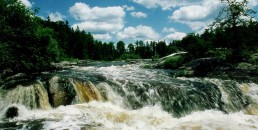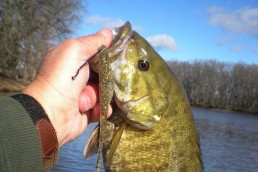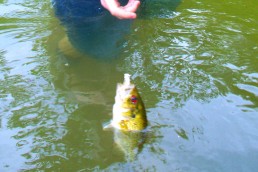How to Fish Waterfalls and Drop Dams
SHARE THIS POST
The roar and hiss of the Gravel River Falls is still a part of my river education. My father, Don Gapen, taught me how to work falling water on a companion river, the Cypress. It was a simple matter of casting your fly—a weighted model—high into the fall’s overflow where water tumbled over the breaking lip and allowing enough free line to run as the dropping water pulled line through your hands. This free line would then be pulled down with the plunging water to see your lure or fly enter the dig-out pocket, which can be found at the bottom of each waterfall or dam.
That day at the high falls had been preceded by several trips coming up the Gravel with a square stern canoe. The 24-mile stretch of this snaking river channel took a great deal of time, mainly because we just had to fish the good-looking structure. This day, we’d come upon a new “highway gravel pit” within a block of the river less than a mile above the falls.
As we neared the falls I told dad that I’d fish the upper falls and let him descend to the lower structure. The upper was a 12-foot torrent dropping straight down, while the lower falls was similar but appeared to be more than twice the drop size (25 feet or more). No fish would be able to climb this torrent of water. This proved to be true. All I caught in the top falls were brook trout, however, one was at 2 1/2 pounds. Unlike the bottom falls, I was forced to stand in knee-deep water and cast directly up to the top of the breaking foam, close to the shore where a lack of birch trees presented an easy back-cast. Dad would have it much easier; the lower falls carried thigh-deep water across the channel where one could work a fly up into cascading water.
Finally, when I decided to depart the upper falls and scurry my way down to where my father would be fishing, he’d just disappeared.
Then, I heard him call, “Gander! I hooked a monster rainbow—must’ve been near 10 pounds!”
He exclaimed said it took him downstream around the bend and into a brush and log pile.
“I couldn’t stop him!” was father’s excuse, as he sloshed up around the bend 50 yards downstream.
Yup— that fish proved a point: post-spawn rainbows will often stay in the river if sand structure is available and plenty of food exists.
Our previous trips up to the high falls by canoe had seen us arrive late for the morning feed and too early for the evening one. (Tip: Steelhead, commonly known as rainbow trout, do most of their feeding from sunup to 10 a.m. and feed once again at 6 p.m. and stop one half hour after dark. You can catch 6- to 15-inchers during the bright of day, but if after trophies, take the early-morning and late-evening advice.) By the time dad reached me I’d dropped my weighted number 6 Muddler into the dig-out and was into a healthy 5-pound rainbow that was leaping her way downstream with me in pursuit.
Before she reached the bend I managed to put enough stress on the line to see her turn back upstream. With father now watching every move I made, the fat fish was subdued, and in his net.
“Gander—honestly! The fish that broke me off was twice the size of this one!” dad shouted, knowing his trout.
I then had no doubt he was telling the truth.
By using the cast up into the falls, free lining and getting into the dig-out method, we managed 13 nice trout, mostly rainbows. Father took the largest—an 8-pounder. The six brookies landed were all between 10 and 16 inches. Three of the rainbows were the size of the first one I had taken, and my biggest tripped the scale overt 7 pounds. We kept several brook trout to eat, but released all the rainbows. The orange meat of the native brook trout has been preferred by my family and is by far the best to eat.
Drop dams
It was a sultry day in Chicago in August when Mike Sparrow called me. MidWest Outdoors invited me to go after some flathead catfish on the Fox River. “Bobber” Anne had been down to the Ed Shirley Sports Store and just finished up.
Why not? It was too late to head home, and Mike assured me that the Fox flats were on the bite. We then decided to meet at the Aurora Dam.
True to his word, Mike was there when we arrived.
“Dan, the water’s low and we can wade out to a point 35 feet downstream from the dam face. There’s only one deep spot, waist-deep near this shore, to worry about. I’ve got the lure—bluegills.”
Are you enjoying this post?
You can be among the first to get the latest info on where to go, what to use and how to use it!
Live bluegills are by far the best baits for flatheads. When hooked under the back fin and left to swim near a flathead, you’ll be into that fish within minutes.
How big were the bluegills? In most cases, hand-size, which is ideal. Loaded on a 3/0 or 4/0 offset hook, and you can’t beat the combo. On the strike, you can hook-up on 95 percent of your bites.
Ten minutes later, with Anne trailing a Flow Troll bucket tied to her belt and a video camera in hand, we waded into the tailrace waters at the Aurora Dam.
Once at the middle, some 60 feet below the dam, Mike and I stopped and each picked a 4-inch bluegill out of the bucket.
I finished my hooking first and cast toward the top of the descending water.
“Why are you using this approach?” Mike asked.
I explained the dig-out theory to him and suggested that if I laid my cast 10 feet to the left, there was a huge dig-out at that spot below the dam.
Even so, within minutes, my 2-ounce Bait Walker Sinker and its bait of bluegill was rewarded with several taps.
Then, after several seconds of patience, I made another set of taps. Slowly, I reeled in line until it lightened up a bit. At that point a set was applied, and moments later a 7-pound flathead was slapping on the one piece of exposed gravel between us.
Mike had taken his own advice and cast to where the deeper dig-out was.
Before I released my small flat, Mike yelled, “Big fish on,” as he reefed hard twice.
It took my partner nearly 12 minutes to subdue his 18-pound flathead. Meanwhile, I was into that bigger dig-out and was also struggling with a large cat.
Once landed, we held our prizes up for Anne to film. It was her turn as I took over camera duty. In all, the three of us caught, filmed and released 14 flathead cats that evening, with the largest a 23-pounder, and the smallest, my 7-pounder. Several were lost, including a huge one that sent Mike sloshing downriver after it until the Fox’s water level reached his neck. At that point, Mike put the brakes on and had broken his 20-pound line.
Anne and I had been using Bait Walker Sinkers to prevent snags in the rocky bottom; Mike used 2-ounce egg sinkers he had to break off several times as they got stuck in the rocks.
If you have a river like the Fox with a drop dam nearby, it’s a thrill to seek out the dig-outs. Cast high on the water drop and get into those big cats, walleyes or bass by using my technique taught to me by my father. (Also, instead of 20-pound-test line, up it to 30- or 40-pound-test for the cats.)
Surprisingly, the catfish will often become your victims when fly fishing a drop dam or waterfall using the methods described in this article. Just remember to cast up at the top of the falling water, allow it to free-line, lighten it up, and then wait for the “tap-tap.”
MWO
SHARE THIS POST
Did you enjoy this post?
You can be among the first to get the latest info on where to go, what to use and how to use it!
Dan Gapen
Considered one of the world’s leading river anglers, Dan Gapen, Sr. has shared his knowledge with MidWest Outdoors readers and viewers for more than 40 years. He is a member of all three Fishing Halls of Fame—International, National Freshwater, and Minnesota. He has an immense grasp of the world’s fisheries. He may be contacted at 877-623-2099.
@TheGapenCompany.



